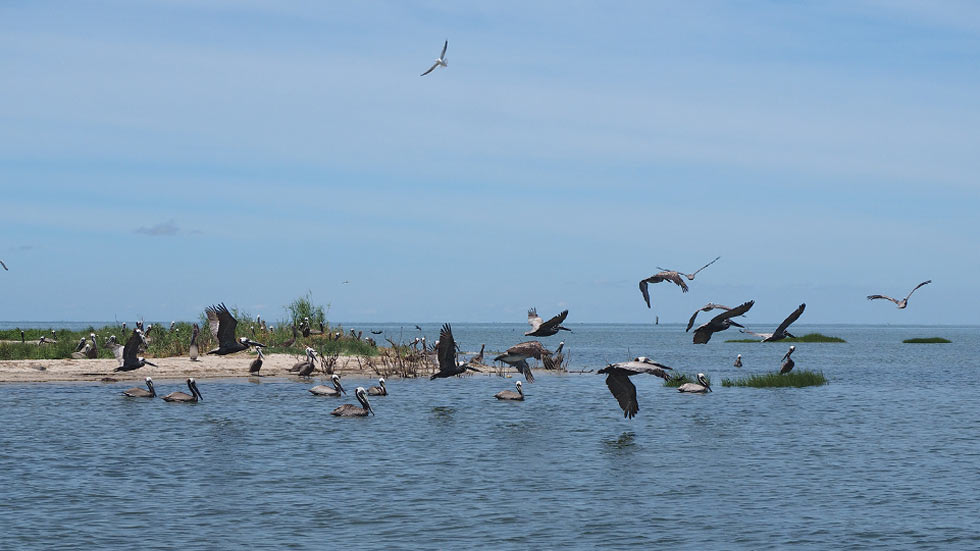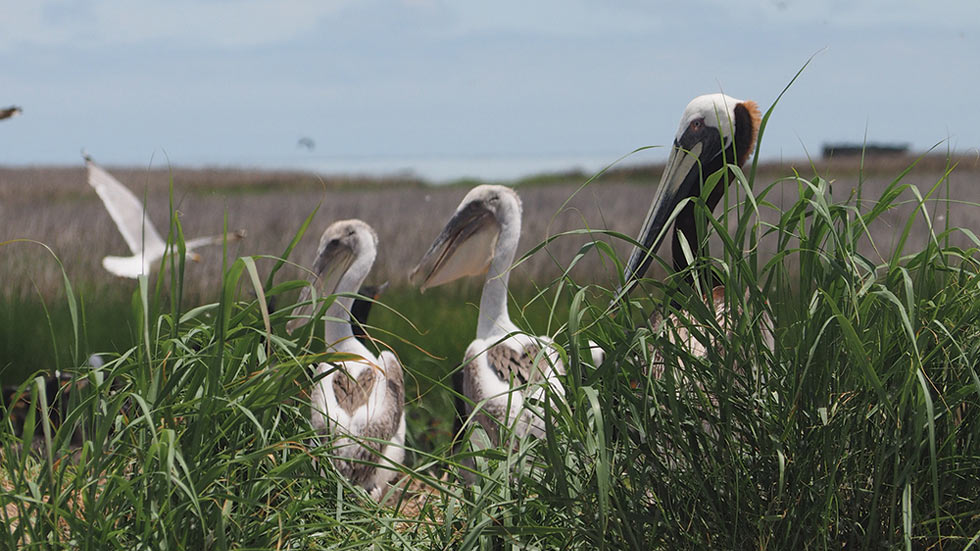The Galápagos of the Chesapeake Bay
Every year, a few small uninhabited islands in the Lower Chesapeake host some 5,000 nesting brown pelicans—and their chicks—in their northernmost breeding ground











The first pair arrived in the Chesapeake Bay in 1987, wayward souls far from their usual territory, looking for a suitable place to build a nest and lay their eggs. When those renegade brown pelicans returned south, they must have spread the word in their community about the marshy protected lands that form an archipelago in Tangier Sound.
Ever since, brown pelicans have been returning each spring and summer in increasing numbers to the uninhabited islands surrounding Smith Island, Maryland. The nesting pelican population took off in the late 1990s, and in recent years, an estimated 2,500 pelican pairs have journeyed from Florida and the Caribbean to nest in the Chesapeake Bay, their northernmost breeding grounds (climate change having made this area warmer than ever).
PELICAN PANOPLY
It was late June, and I had joined 17 other nature lovers on one of Delmarva Birding Weekend’s daylong Smith Island Pelican Tours. We’d come to see the spectacle that our guide, Jim Rapp, likens to entering Jurassic Park. Rapp and business partner Dave Wilson own the birding tour company offering the expedition.
“Sometimes wildlife watching is just glimpsing that one rare bird, and that’s all that matters. But to see this many living birds, and they’re so prehistoric—it looks like a big pterodactyl colony.”
We had left at 8 a.m. from Somers Cove Marina in Crisfield, on Maryland’s Eastern Shore, aboard the Barbara Ann II, a 45-foot walk-around cabin boat that ferried us 12 miles west to Smith Island.
The day started auspiciously with a fabulous view through binoculars of a mother peregrine falcon and her two month-old chicks. They occupied an old osprey nest atop what remained of the former Somers Cove Lighthouse, just outside the marina (the structure has since collapsed).

Photo by Blair Caldwell
Rapp points out that the sight is exceedingly rare, as peregrine falcons typically nest in rocky cliffs (or, in a pinch, in a skyscraper).
“When we were out here in early June, the chicks were covered in fluffy white down, their feathers just starting to come in,” Rapp says. “Now you can see there’s one little puff of down among the feathers. They’re losing their baby down right before our eyes. A big gust of wind is going to take that right off.”
Minutes later, as we neared the town of Ewell on Smith Island, we spotted hundreds of seagulls whirling above a high, mounded natural island and making quite a racket. The seagulls, too, had found these islands to be a perfect place to nest—away from most people and far from any predators on land.
The skies, marshes and waterways through which we passed that day were rife with birds: a variety of herons—whites, great blues, greens, tricoloreds as well as yellow-crowned and black-crowned night herons—several types of egrets, cormorants, oystercatchers, willets and ducks.
We docked in Ewell for a little birdwatching on land (we saw clapper rails, seaside sparrows and marsh wrens in the marsh bordering a main road) and then motored over to Tylerton to lunch at Drum Point Market on crab cakes and corn-on-the-cob, finished off with a slice of multilayered Smith Island Cake. Sated and happy, we separated into three skiffs and set off for the main attraction: the nesting brown pelicans.
BIRD BY BIRD
Birds come in great varieties and great numbers to these uninhabited islands. They come not only because of the remoteness of the islands, accessible only by boat, but also because of the Glenn Martin National Wildlife Refuge.
The refuge covers more than 4,500 acres, including the northern half of Smith Island as well as Martin Island and Watts Island. The tidal marshes, coves, creeks and ridges of the refuge provide important resting areas and winter homes for thousands of migratory waterfowl, and, in spring and summer, they offer prime nesting habitats.
“A birding tour here is like visiting the Galápagos for an afternoon,” Rapp says.
But of all the birds that pass through the wildlife refuge, perhaps none is as special as the brown pelicans, which commonly nest in the warmer climes of the US South, the Gulf Coast and California. Birders and nonbirders alike are surprised to learn about this Mid-Atlantic phenomenon.

Brown pelicans; Photo by Jay Fleming Photography
Brown pelicans are the smallest of the seven pelican species. Adults weigh 8 to 10 pounds and can be up to 54 inches long. Their wingspans average an impressive five-and-a-half to six-and-a-half feet.
“They can look awkward and bumbling on land, but in the air, they’re just so graceful,” Rapp says.
THE MAIN EVENT
In the smaller six-passenger skiffs, we’re able to navigate narrow channels and venture close to shore for outstanding pelican-viewing. The refuge prohibits landing and walking on the islands, though we probably wouldn’t have done so regardless. As with any reputable ecotour company, Delmarva Birding emphasizes respect for nature, and we don’t stick around any one area too long in order to avoid disrupting the birds.
We first approach a small island with dozens of nesting pelicans, a prelude to the mother lode of pelicans we see elsewhere that afternoon: island after island with hundreds of nesting pairs.
“Now you can really smell that pungent whiff of mud and poop and fish. We joke that we’re going to bottle the scent and sell it as Pelican Perfume in the gift shop at the Smith Island Cultural Center,” Rapp says, chuckling.
As we get close to the birds, we notice an unusual behavior. I ask Rapp, “What’s that flappy thing they’re doing with their necks?” It’s called a gular flutter, he explains, and it’s how the bird cools off, much the same as dogs pant or humans sweat when overheated.
If, as was the case for me, you’ve never seen gular fluttering, the behavior is fascinating to observe. See for yourself in the video below.
Video courtesy of WBOC’s Outdoors Delmarva
BABY GROWS UP
The pelicans build nests on mounds of marsh grass with its strong, tightly interwoven roots. Closer to the shoreline, nests must be taller, and the birds add sticks to the marsh grass to raise the nests up and help prevent them from being washed out by high tide or storms.
Mixed in among the pelican nests are those of cormorants, as the two species nest symbiotically. They help to protect each other’s eggs and chicks from predator birds, and they also prevent seagulls from swooping in and stealing the fish that the parents feed their babies.
Brown pelicans lay one to three eggs at a time. Here in the Chesapeake, an average of one-and-a-half chicks per nesting pair survive to fledging. That’s a good percentage, says Rapp, who adds that the survival rate here is better than in many areas in the South.
The early birds start to arrive in the Chesapeake in late April; most of them have come by mid-May. Brown pelican eggs hatch 35 days after they’re laid, making June and early July prime pelican-viewing season.

At about seven weeks, pelican chicks appear to have a brown heart on their backs. Photo by Blair Caldwell
“Baby pelicans are naked when they hatch, and their skin is black. Then they get their white down, and they’re like little white puffballs for the first few weeks,” Rapp explains. “The down starts to fade as brown feathers come in, until the chicks are all brown.”
Because pelicans fold their wings behind them, there is a very brief time—say, at age six or seven weeks—when a chick’s wings are still white and downy, but its back has brown feathers. When the wings are tucked back, a perfect brown heart can be seen in the middle of the chick’s back.
“People call or Facebook-message us saying, ‘I want to come when the babies have hearts on them.’ And, yeah, that’s fun to see, but we can never guarantee that,” Rapp says. Lucky for me and my fellow tour members, we saw many such charming pelican hearts that day.
The parent pelicans feed their chicks menhaden, herring and other oily fish. “There’s enough fish in these waters to fatten up those babies and get them flying and building up their muscles so they can head south before temperatures cool down too much,” Rapp says. Seventy-five days after hatching (some three-and-a half months after the eggs were laid), the chicks are developed enough and able to fledge, and the family is ready to begin its return journey south.
By the time you read this story, the pelicans will soon be winging their way back north to summer again in the Chesapeake.
Visit DelmarvaBirding.com to book your Smith Island Pelican or other birding tour. Read more about Smith Island attractions at AAA.com/Smithisland. And to learn about tourism in Somerset County, Maryland, beyond Smith Island, go to AAA.com/Somersetmd.
